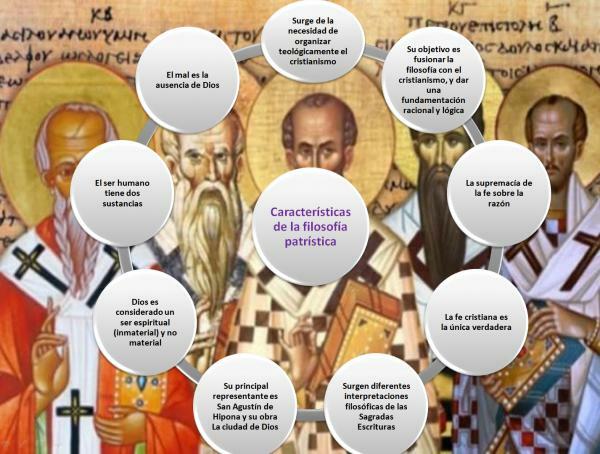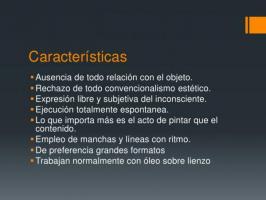15 CHARACTERISTICS of the PATRISTIC philosophy

In this lesson from a TEACHER we will talk about characteristics of patristic philosophy, which developed between the I-VII century d. C. and is defined as the study of the thought and doctrines present in the works of the Fathers of the Church. Likewise, its objective is to unify the Christian religion and define a dogmatic content against paganism from greek philosophy (Platonism and Neoplatonism) to give a logical explanation to its great mysteries. If you want to know more about patristic philosophy, continue reading this article. The lesson begins!
The patristic, whose name comes from the Latin term patres=parents, was developed in the Middle Ages since the last stage of writing the New Testament (Acts of the Apostles- S.I d. C.) until Second Council of Nicea (784). This period of time is divided into three stages:
- First Patristics: S.I-III d. C.
- High Patristics: IV - V d. C.
- Late Patristics: VI- VII d. C.
During this period of time, the objective was organize Christianity theologically,
create a dogma and interpret the Holy Scriptures from philosophy. However, these interpretations were not without controversy, since the interpretations that led to complex Christological debates from different schools (East, North Africa and West) and from two variants of patristics (East and West).The main characteristics of patristic philosophy are as follows:
- It arises from the need to organize Christianity theologically and to create a dogma.
- It extends over time, from the I-VII century, and has its period of greatest splendor during the Middle Ages.
- Your goal is merge philosophy with Christianity, give a rational and logical foundation to Christian dogma from Platonic and Neoplatonic philosophy (Plotinus, 205-270). Leaving aside the philosophy of Aristotle and the Epicureans.
- The supremacy of faith over reason: At all times faith is superimposed on reason, because faith leads us to know God, it is the truth and there is no knowledge superior to it. It is, then, a relationship of subordination (believing to understand) in which God illuminates reason.
- Christian faith is the only true against heresy and paganism.
- Different philosophical interpretations of the Holy Scriptures emerge that crystallize in different schools, different types of patristics (East / West) and debates that are tried to be solved in different councils.
- As a result of the different interpretations, heresies will arise within Christianity: Arianism, Docetism, Apollinarianism, Nestorianism, Monophysitism, Monotelianism ...
- The main representative of him is Saint Augustine of Hippo and his work The city of god: The existence of two worlds / cities (an earthly one where mortals reside and the heavenly one where God and souls are found).
- God is considered a spiritual being (immaterial and non-material), supreme, perfect, omnipresent and guide of man.
- The search for God must be voluntary and love and happiness must be found in God.
- Providencialism: everything happens by the will of God.
- The human being has two substances, the material (body) and the spiritual (soul), and the body turns out to be the prison of the soul.
- Evil is the absence of God and arises through man's disobedience to God (original sin), therefore, evil does not have an existence of its own.
- Establishes the foundations of the Church: the same term comes from the word father = fathers of the Church.
- The idea of purity and morality are consolidated.
And with this, we finish the review of the most prominent and recognized characteristics of patristic philosophy.

The schools and debates arise through the different approaches made by the first Christians of the Sagradas Scriptures on such matters as the nature of Christ, the nature of Mary, or the relationship of Christ to God.
Approaches, that the first Christians who lived in a Hellenistic environment they tried to answer by going to philosophy. Which, gave rise to the birth of important centers o theological schools that, leaning on the philosophical lines of Ancient Greece, they tried to answer these questions. Thus, two schools stood out, that of Antioquia and the school of Alexandria with two different positions:
School of Antioch (Syria and Turkey)
With representatives like Pablo from Samosata (200-275), Lucian of Antioch (312), Diodorus of Tarsus (394), Theodore of Mopsuestia (350-428) or John Chrysostom (347-407), this school stood out for:
- Interpretation and literal, grammatical and historical study of the Holy Scriptures (Lucian of Antioch, Diodorus of Tarsus).
- Method of explanation and interpretation (exegesis) rational and scientific, influenced by Aristotle (Juan Crisóstomo).
- Differentiation between the divine and human nature of Christ. Jesus was a man, he grew and developed as such, therefore, his personality was human but he had the wisdom of God.
- Position reluctant to claim that Mary was the mother of God, Theotokos.
- He defended that Christ was a historical person (with freedom) with two different natures (Logos-Anthropos, verb / human) and that the Son was not God.
School of Alexandria (Egypt)
With representatives like Panteno (200), Clement of Alexandria (150-215) u origins (185-253), this school stood out for:
- Allegorical interpretation, study and method in the analysis of the Holy Scriptures: the Bible had an allegorical significance (together with the literal, the moral, the typological) that had to be interpreted to find the true meaning and the mysteries that the text. Therefore, for the Alexandrian school the literal interpretation was unworthy of God.
- Tendency to mysticism and theological speculation, totally moving away from rationalism / historical realism.
- Union of divine and human nature in Christ. The Son (Word) is born of God and derives from his being (the Logos / Word had been produced by the Father). This affirmation led to subordinate human nature to the divine and the Logos to the Father.
- In God there were three individualities (Father, Son and Holy Spirit).
- Defense of the title Theotokos, Mary was the mother of God.
Both schools, with different positions, stood out for debating issues such as the mystery of the trinity (the relationship between Christ-God-Holy Spirit) or the nature of Christ (whether or not two natures coexisted in it) in various councils (Council of Nicaea-325-, First Council of Constantinople-381-, Council of Ephesus-434-, Council of Chalcedon-451-, Second Council of Constantinople-553-, Third Council of Constantinople- 680-681…)

Image: Slideshare


